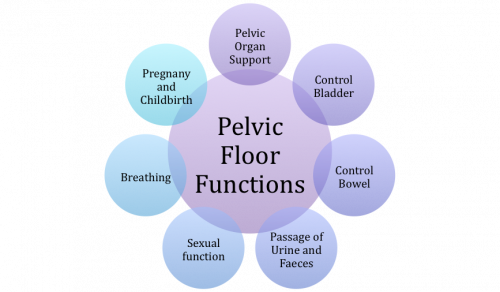Pelvic Floor Exercises
Original Editor - User Name
Top Contributors - Audrey Brown, Ruchi Desai, Vidya Acharya, Kim Jackson, Lucinda hampton and Khloud Shreif
Introduction[edit | edit source]
The pelvic floor, also known as the pelvic diaphragm, are a collection of muscles that span the floor of the pelvis. The pelvic floor muscles enclose the pelvic viscera, including the bladder, intestines, and uterus (in females) and separate the pelvic cavity above from the perineal region below. [1]The pelvic floor supports abdominal and pelvic viscera, maintains bowel and bladder continence, and functions in voiding, defecating, sexual activity, and childbirth.[2]
Weak, strained, or overly tight pelvic floor muscles can lead to pelvic floor dysfunction, which may include pelvic pain, urinary/bowel incontinence, pain with sex, sexual dysfunction, and pelvic organ prolapse. [3]
Pelvic floor exercises can strengthen and increase neuromuscular control over the pelvic floor muscle and may reduce or eliminate symptoms associated with pelvic floor dysfunction.[3]
Indications for Pelvic Floor Exercise[edit | edit source]
The below symptoms may indicate the need for Pelvic Floor Exercises in all genders:
- Urinary incontinence/frequency/urgency [4][5]
- Pain in pelvic region, genitals, perineum, or rectum [5]
- Sexual dysfunction including erectile dysfunction, pain or numbness in the genitals during or after sex [6][7]
- Pelvic organ prolapse, which may be felt as a bulge in the vagina (feeling or seeing a bulge or lump in the vagina or coming out of your vagina) or a feeling of heaviness, discomfort, pulling, dragging or dropping. [8]
Activating the Pelvic Floor Muscles[edit | edit source]
Pelvic floor exercises begin with learning to simply activate the pelvic floor muscles.
- The first step is to find a comfortable position, attempt to relax all muscles, and focus on a steady breathing pattern.
- To activate the anterior pelvic floor muscles, replicate the action of stopping the flow of urine mid-stream. [9]
- To activate the posterior pelvic floor muscles, replicate the action of stopping passing gas. [9]
- To activate both the anterior and posterior pelvic floor muscles, combine the two above actions. [9]
When activating the anterior pelvic floor muscles, it is important to not actually stop the flow of urine mid-stream when using the bathroom, as this may lead to difficulty with fully emptying the bladder.
Specific Exercises[edit | edit source]
Kegel[edit | edit source]
The Kegel exercise is probably the most widely known pelvic floor exercise. It consists of an isometric contraction of the pelvic floor muscles.
To do a Kegel exercise, follow these steps:
- Start by holding your pelvic floor muscles in for 5 seconds. It is important to keeping breathing during this contraction.
- After holding for 5 seconds, slowly and completely relax your muscles for 5 seconds.
- Repeat this process 10 times, at least 3 times every day.
Your pelvic floor muscles may get fatigued during this exercise. If this happens, stop and do the exercise at a later time.
Don’t use your stomach, leg, or buttock muscles when doing this exercise.
As you continue to practice these exercises, you should increase the time you hold and rest your pelvic floor muscles. Start with 5 seconds, and slowly build up the time each week until you’re holding in and resting for 10 seconds.[10]
Diaphragmatic Breathing[edit | edit source]
Transverse Abdominis Activation[edit | edit source]
Biofeedback[edit | edit source]
Relaxation Techniques[edit | edit source]
Resources[edit | edit source]
- Pelvic Floor Strengthening Techniques from the NHS: https://healthandcarevideos.uk/bladder?videoId=1595
- Pelvic Floor Relaxation Techniques from the NHS: https://healthandcarevideos.uk/bladder?videoId=1596
References[edit | edit source]
- ↑ Bharucha AE. Pelvic floor: anatomy and function. Neurogastroenterology & Motility. 2006 Jul;18(7):507-19.
- ↑ Mantle J, Haslam J, Barton S, Polden M. Physiotherapy in obstetrics and gynaecology. Butterworth-Heinemann,; 2004.
- ↑ 3.0 3.1 https://www.nhs.uk/common-health-questions/womens-health/what-are-pelvic-floor-exercises/
- ↑ Pelvic Obstectric and Gynaecological Physiotherapy. 2016. Pelvic floor muscle exercises (for men)[online] [viewed 26 March 2018]. Available from: http://pogp.csp.org.uk/publications/pelvic-floor-muscle-exercises-men
- ↑ 5.0 5.1 NHS Choices. 2017. Living with incontinence [online] [viewed 28 March 2018]. Available from: https://www.nhs.uk/Livewell/incontinence/Pages/Livingwithincontinence.aspx
- ↑ Women's and Men's Health Physiotherapy. 2017. Leading the way in pelvic health [online] [viewed 28 March 2018]. Available from: http://www.wmhp.com.au/
- ↑ Male Pelvic Floor. 2012. Sexual Dysfunction and the Male Pelvic Floor [online] [viewed 29 March 2018]. Available from:http://malepelvicfloor.com/sd.html
- ↑ Pelvic Floor First. 2017. Pelvic Floor First [online] [viewed 26 March 2018]. Available from: http://www.pelvicfloorfirst.org.au/pages/how-can-i-tellif-i-have-a-pelvic-floor-problem.html
- ↑ 9.0 9.1 9.2 Polden, M. and Mantle, J., 1990. Physiotherapy in obstetrics and gynaecology. Elsevier Health Sciences.
- ↑ https://www.mskcc.org/cancer-care/patient-education/pelvic-floor-muscle-kegel-exercises-men







